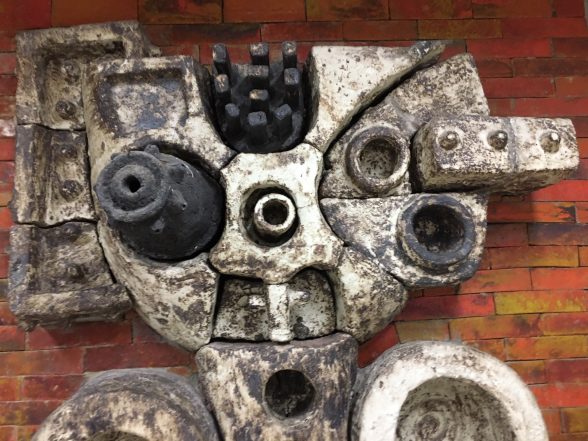This website uses cookies
This website uses cookies to enable it to function properly and to analyse how the website is used. Please click 'Close' to accept and continue using the website.



This time last year, we had just began our C20 trip to India. Many of us who travelled there were struck by the murals by Satish Gujral, which are prominent in the entrance halls of two of the most impressive buildings we saw in Chandigarh (the Corbusier designed Government Museum, and the Gandhi Bhawan by Pierre Jeanneret). He was also the artist of the alphabet mural on the outside wall of the Delhi High Court. However, described by the Indian National Herald as a ‘multifaceted master modernist’, Gujral was far more than just a muralist, he was an architect, painter, sculptor, graphic artist and writer as well. The younger brother of Inder Kumar Gujral (Prime Minister of India from 1997–98), he was born in Jhelum in undivided Punjab in British India. In 1939 he enrolled for five years the Mayo School of Industrial Art in Lahore, then headed by Rudyard Kipling’s father whom Gujral described as belonging “to the old school which believed that all visual expressions are one”, and led a very broad curriculum as a result. Gujral then specialised in painting at the Sir JJ School of Art in Mumbai. His artworks, particularly his paintings including anguished figures, have been interpreted as a response to the turbulence of the partition of India in 1947 (when he was back in Lahore and saw much violence), but he also saw them as an expression of his own personal difficulties, including deafness and disability resulting from a traumatic childhood fall into a river.

In 1952, rather than following many of his contemporaries to Paris or London, he received a scholarship to study at the Palacio de Bellas Artes in Mexico City, where he was apprenticed to Diego Rivera and David Alfaro Siqueiros. Whilst there Frank Lloyd Wright, with whom he was to disagree strongly about the role of murals, visited. He asked Wright why he had never commissioned Rivera to do a mural for one of his buildings. The reply was “if there is a dead wall, then I would want an artist to give life to the dead wall by painting a mural, but I have never built a dead wall” which he followed with the assertion that “to do a mural for architecture is to deny the right to both mediums to be independent”: in contrast Gujral believed that “all mediums are one”.

Winning the competition for a new Belgian Embassy in Delhi (1980–83) proved controversial, because he was not a qualified architect, but the fortress-like complex in brick was widely regarded as very successful. ‘I had not thought of architecture in intellectual terms,’ he was quoted as saying in the New York Times obituary. ‘I just designed it through some kind of instinct, and when I had finished I still did not know what I had done. As always with creative work, an artist is himself surprised by what he has produced.’

Become a C20 member today and help save our modern design heritage.
Comments